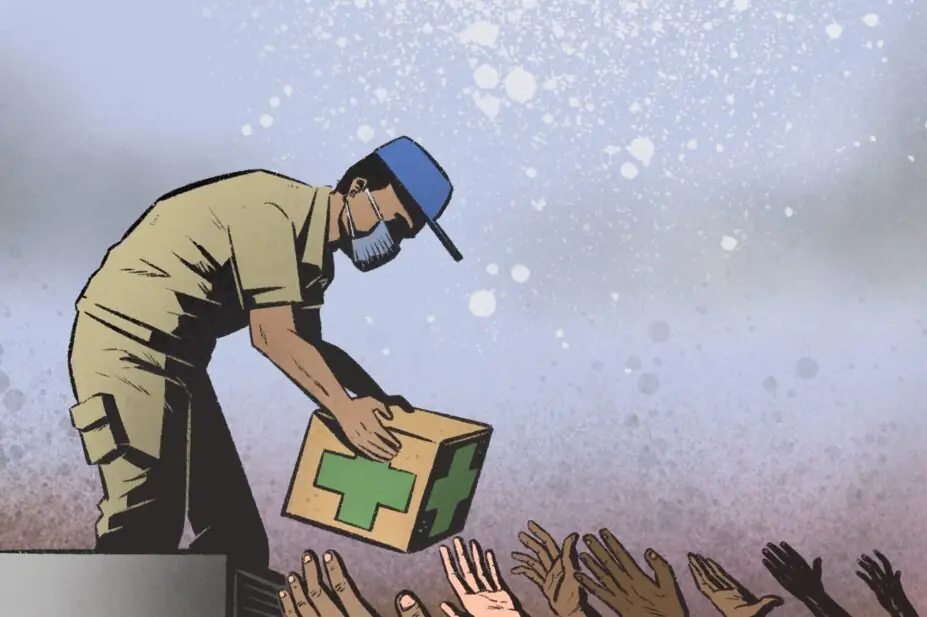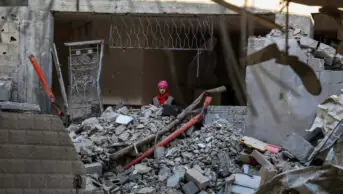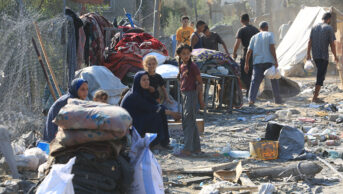
Wes Mountain/The Pharmaceutical Journal
Despite a rise in human-made and natural disasters, the humanitarian sector is the road less travelled for the pharmacy workforce1–4. Humanitarian workers are exposed to multiple exceptional factors, such as unstable environments, neglected diseases and unfamiliar living conditions4. It is a vastly different environment to hospital or community sectors in developed countries, yet a fundamental common aim links them — to provide the best possible quality of care to those in need1–4.
Humanitarian pharmacy professionals are a vital link in the access and management of medicines and health technologies, and are drawn into the humanitarian sector by a passion to help the vulnerable in times of uncertainty5,6. Their wide-ranging backgrounds and levels of practice influence medication management in diverse settings7. Pharmacy professionals can be close to field operations — based within individual projects, such as hospital complexes or outreach clinics, in country-wide coordination positions streamlining medical orders, or in regional and global support roles framing and implementing medical policies. All the while ensuring that medical items ordered to the field reach their intended use.
The International Pharmaceutical Federation’s ‘Global humanitarian competency framework’, published in 2021, outlines pharmacy expertise across patient, system and population-wide scopes of practice5. Thus, where humanitarian aid is needed, pharmacy practice can include the more obvious activities of providing safe access to medication, monitoring therapy and counselling patients on their medicines, as well as allowing their expertise to permeate into wider public health efforts, such as supply chain management and liaising with governing bodies.
It is now for the pharmacy profession and its medical allies to promote pharmacy expertise, not only in hospital and community settings but also in the humanitarian sector
There is a noted shortage of humanitarian pharmacists and pharmacy technicians, for reasons that include variable career pathways and opportunities between home and deployment countries and suboptimal recognition in drug supply cycle and clinical roles7–9. A decade ago, “there [was] a crucial need to identify pharmacists with [humanitarian] experience, capture their expertise and formulate best practice”10. Amid ongoing humanitarian disasters, improvements have been made in humanitarian pharmacy practice, including the creation of the competency framework, yet the ongoing need for workforce development stands5. It is now for the pharmacy profession and its medical allies to promote pharmacy expertise, not only in hospital and community settings but also in the humanitarian sector.
Monitoring and optimisation of medical stock
Humanitarian pharmacy teams are essential in medical stock management. Expertise needs to flourish into medical stock optimisation, unhindered by organisational understanding of the profession’s scope of practice, and into a humanitarian pharmacy workforce that is increasingly clinically relevant and positively impacting patient experience everywhere7.
In a medical humanitarian organisation, a pharmacist colleague noted that ‘[medical] stock cannot be managed without a clinical approach’. This voice is echoed across the sector2–4. The optimisation of medical resources for clinical use relies on expertise in medical stock management6,11. In humanitarian terms, medical stock includes all medical items needed for the running of a healthcare facility: medication, needles, biomedical equipment, hospital beds, masks, gloves and more; each item defined and quantities adjusted to the medical activities of a given project. Correct stock management and surveillance can ensure there is optimisation of the available medical resources.
The overall aim of stock surveillance is to review ‘ROSE’ — Ruptures (out of stock items), Overstock, Sleeping stock (unused items owing to e.g. change of medical activities) and Expired items. Stock surveillance and subsequent action to minimise ‘ROSE’ are essential pharmacy activities for the running of humanitarian projects and to allow accurate budget and stock forecasting. In the humanitarian sector, medical stock is planned and ordered far in advance of actual usage (sometimes six to nine months or more) owing to the issues of accessing quality controlled stock, transportation and importation realities. Any medical stock order omissions or miscalculations can cause detrimental effects to the project’s medical activities, such as insufficient supplies reaching surgical theatres or medications not being available for patients.
Currently, there is no consensus on who is responsible for medical stock and within different humanitarian organisations there are varying professional groups that oversee medical stock. Globally, medical stock management and distribution is better framed than within the humanitarian sector8. From their training, pharmacists are vital in the process as they understand all aspects of the medication journey and, once in the humanitarian sector, become versatile to manage and strategically oversee the entirety of medical stock. Humanitarian pharmacy teams have the skills to monitor consumption patterns, advise on changing therapy options and propose alternatives when there are medication shortages, rationalising the distribution and optimising the use of medical resources to end-user units9.
Good stock awareness links intrinsically to the quality of patient care. When there are limited resources, pharmacists assess cost-effectiveness through a clinical lens and can support medical teams in the prioritisation and implementation of new medical products. Pharmacy professionals are well placed to monitor and analyse consumption, identifying poor prescribing practices of clinical impact5,9,12. This prescribing mapping allows for targeted training to streamline the use of healthcare resources and in turn impact patient outcomes.
Recognition by humanitarian organisations
Pharmacy teams are an integral part of delivering healthcare9 and recognition by humanitarian organisations is crucial to maintaining pharmacy expertise within their healthcare structure. With a defined competency framework5, humanitarian organisations can capitalise on their pharmacy workforce, allowing pharmacists to practice their core competencies from stock management and surveillance to stock optimisation and clinical service provision, without limiting them to one or the other.
Pharmacy teams speak the same ‘language’ as medical stock users, such as doctors, nurses and allied healthcare professionals
Removing pharmacists from monitoring stock — specifically from managing the teams that handle medical stock — can lead to a decrease in medical expertise, reducing resource optimisation and limiting access to that stock by the medical teams that need to use it. As part of the clinical group, pharmacy teams speak the same ‘language’ as medical stock users, such as doctors, nurses and allied healthcare professionals. This affords greater visibility for the medical team as to what products are available and when. It also creates an opportunity for the pharmacy team to propose alternatives and question overconsumption or underusage of items in view of forecasted amounts and ongoing medical activities9,12,13.
The humanitarian sector adapts to often complex medical supply chains with long lead times. Pharmacy activities, including medical item substitution and optimisation to prevent stockouts of critical medicines, or unnecessary amounts of expired stock that then enter an equally complex destruction pathway, are continuous and pragmatic. Pharmacy teams handle medical stock with an attention to detail and a focus on patient care that can benefit any humanitarian project. Support for pharmacy teams and endorsement of capacity enhances their decision-making power, promoting their autonomy to optimise medical resources in line with humanitarian goals.
Pharmacy teams are mandated with their expertise to optimise medication and improve quality of care. Their role is crucial in the humanitarian sector, extending to optimisation of all medical resources where those resources are scarce and often difficult to access. It is imperative that pharmacy as a profession is involved in every aspect of overseeing the distribution of medications and other medical resources, through to their use by patients, such that at the end, ‘every pill reaches the patient’.
Declaration of interest
The authors did not declare any conflicts of interest when submitting this article.
- 1.Kersten R, Bosse G, Dörner F, Slavuckij A, Fernandez G, Marx M. Too complicated for the field? Measuring quality of care in humanitarian aid settings. Global Health Action. 2013;6(1):20311. doi:10.3402/gha.v6i0.20311
- 2.Claycomb J. A need for pharmacists in humanitarian aid work. Pharmacy Times. 2018. Accessed September 2024. https://www.pharmacytimes.com/view/a-need-for-pharmacists-in-humanitarian-aid-work
- 3.Humanitarian pharmacists: the road less travelled. Pharmaceutical Journal. Published online 2016. doi:10.1211/pj.2016.20200927
- 4.Rasheed H, Nawaz H, Rao A, Bukhari S. Role of Pharmacists in Responding to Humanitarian Crisis. Encyclopedia of Pharmacy Practice and Clinical Pharmacy. January 2019. Accessed September 2024. https://europepmc.org/article/PMC/PMC7150111
- 5.FIP Global Humanitarian Competency Framework (GbHCF). Supporting pharmacists and the pharmaceutical workforce in a humanitarian arena. International Pharmaceutical Federation (FIP). 2021. Accessed September 2024. https://www.fip.org/file/5130
- 6.Albuquerque S, Eriksson A, Alvesson HM. The rite of passage of becoming a humanitarian health worker: experiences of retention in Sweden. Global Health Action. 2018;11(1):1417522. doi:10.1080/16549716.2017.1417522
- 7.Wong A, Hung KKC, Mabhala M, Tenney JW, Graham CA. Filling the Gaps in the Pharmacy Workforce in Post-Conflict Areas: Experience from Four Countries in Sub-Saharan Africa. IJERPH. 2021;18(15):8132. doi:10.3390/ijerph18158132
- 8.Villacorta‐Linaza R. Bridging the gap: the role of pharmacists in managing the drug supply cycle within non‐governmental organizations. Health Planning & Management. 2009;24(S1). doi:10.1002/hpm.1023
- 9.Azmi Hassal M, Thanoon Dawood O. Role of Pharmacists in Health Based Non-Governmental Organizations (NGO): Prospects and Future Directions. Pharm Anal Acta. 2015;07(02). doi:10.4172/2153-2435.1000467
- 10.Marshall S. Pharmacists in humanitarian work. The Pharmaceutical Journal. 2014. Accessed September 2024. https://pharmaceutical-journal.com/article/news/pharmacists-in-humanitarian-work#:~:text=Hilton%20estimated%20there%20may%20only,formulate%20best%20practice%2C%20she%20said
- 11.Jackson S, Martin G, Bergin J, et al. An Advanced Pharmacy Practice Framework for Australia. Pharmacy. 2015;3(2):13-26. doi:10.3390/pharmacy3020013
- 12.Anderson S. The state of the world’s pharmacy: a portrait of the pharmacy profession. Journal of Interprofessional Care. 2002;16(4):391-404. doi:10.1080/1356182021000008337
- 13.Vardanyan H, Mosegui GBG, Miranda ES. Skills and Core Competencies of Pharmacists in Humanitarian Assistance. Prehosp Disaster med. 2018;33(3):266-272. doi:10.1017/s1049023x18000304

